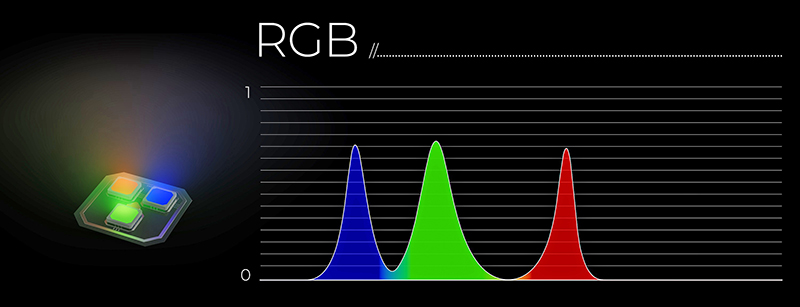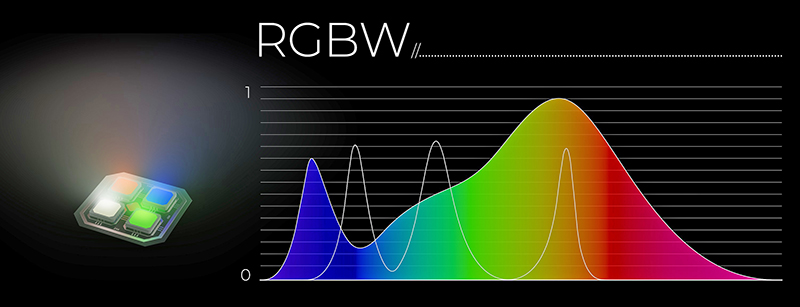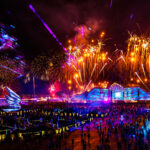
From the first moment that light was projected onto a stage, lighting professionals have been in search of the ideal color palette. The color spectrum is infinite however, and the variety of shades that designers desire—and have sought to create over the years—is immense. It’s no surprise then that recreating the full range of color, and transferring that into an automated luminaire, has been elusive.
For years, subtractive color mixing systems were the default in our industry and the only viable way to achieve a rich color palette. White light from lamps or LED engines combined with gels or subtractive color filters (such as the age old CMY) was seemingly the only option. Additive LED systems that tried to bring a quality RGB alternative mostly failed to produce the rich, saturated color that designers needed, and resulted in unnatural skin tones and a general washed-out look.
Three is not enough
Not all colors can be generated by mixing just three colors, however. It became clear that an RGB only system was limiting access to the color spectrum and was incapable of achieving perfect whites, accurate color temperatures, pastels, and almost any of the desired vivid and deep colors that designers value. Those RGB emitters were only capable of a decent saturated red, green, or blue—everything in between and mixed colors looked unnatural and lacked the accurate hue and saturation that designers desired. When lighting people, sets, or objects, we simply couldn’t achieve the natural tones or color reproduction needed, a fact that was made even more evident when used alongside other conventional or tungsten fixtures.

Full spectrum within reach
Lighting designers have a responsibility to properly light the myriad of skin tones and the intricate detail of costumes and scenery but lacked the proper tools to do so. Elation was determined to find a solution and invested years of research into LED color quality, optics, and consistency. With time and comprehensive research into chromatics and LED emitters, the company realized that the production of luminaires capable of utilizing the full color spectrum was within reach after all. Elation began working with pioneering LED manufacturers to develop multi-array LED engines that could deliver what designers needed—theatrical grade precision instruments that expanded a designer’s creativity and options, not limiting them.
Extra emitters
It made sense, of course, to put more colors into the LED engine design. Extra emitters were added to the RGB and when carefully balanced the overall output was much improved, but better still, access to a broader color gamut was the real benefit. The extra emitters, although an important step in the quest for a true theatrical-grade LED engine, were no cure-all and eventually raised more questions than answers. A new journey of experiments ensued.

White and amber
The early additions to the RGB array certainly helped, such as a dedicated white emitter and amber—which both allowed for dynamic whites to come into play. Often though they were hard to balance with the RGB emitters, and still only gave a modest improvement to the color gamut. Yes, an added white emitter provided access to a wider part of the spectrum and helped with fine tuning colors, but it was clear that the spectrum was still not fully balanced. Amber, for example, isn’t the brightest emitter compared to RGB ones, so giving up space to it as part of the engine wasn’t proving to be the most efficient solution either. An RGBA fixture perhaps gave something extra for event applications but for the theater or opera designer, improvements were marginal. What amber did well however was to offer a better range and control of warmer tones. Now we were starting to get somewhere.
Balance was the key. All these individual emitters by themselves offered nice, saturated color, but how they blended together to achieve a natural color mix was crucial. Was the control of whites enough? Which mixed colors simply weren’t bright enough? Are all colors looking natural on skin? How was the dimming? And what about unit-to-unit consistency?
Problem solving
Answering these questions—or rather solving these problems—tended to uncover other related issues, complicating the solution. Dimming is a prime example. With one LED source, dimming was always a difficult aspect to control to make it look smooth, seamless, and natural. Now you have a fixture with four, five, six emitters, and upwards, all with their own individual dimming characteristics. How to solve all these issues involved the combination of many engineering factors—careful selection of optimized LEDs, batch control of those LEDs, perfect lens/diffusion choice, innovative electronics, and intuitive calibration software to tie it all together.
Adding to the mix
Much of the impetus for a revolution in color can be laid at the feet of the LED manufacturers, who were pioneering new emitters that brought additional criteria to the mix. Mint arrived, giving a substantial boost to overall output. Lime offered a somewhat similar scenario. Yet both offered a differing ability to offer high-quality whites without sacrificing saturation.

It was clear, too, that these new modern emitters would have a different impact for specific applications and for different types of fixtures. An automated spot fixture wouldn’t necessarily need the same color capability as, say, an LED panel for instance. Mint added to an array could be more suitable to helping theatrical whites, pastels, and the unique colors needed for that application. Lime helps to fill in the entire spectrum and has more benefits for TV, film, and broadcast scenarios. Furthermore, an efficient cyan emitter came along, which helps with ultra-precise color temperature control, joining the lime LED to create an expansive color gamut for the demanding world of on-camera work. The result has been LED arrays that can boast a superior balanced color gamut with best overall brightness and more precise fine-tuning of any color.
New creative possibilities
Adding LED emitters to the RGB array has resulted in increased color choice and higher quality light, but most importantly it has opened up for designers a whole new world of creative possibilities. Who knows what extra color emitters will join the LED arrays of the future? Elation’s R&D engineers probably do, but will be tweaking, finessing, and experimenting until every last recess of the color space can be harnessed and made accessible in the latest, cutting-edge luminaire.
Elation Professional, a leading manufacturer of lighting and control solutions for the stage lighting industry, shared this content with PLSN. Learn more about Elation Professional at www.elationlighting.com


